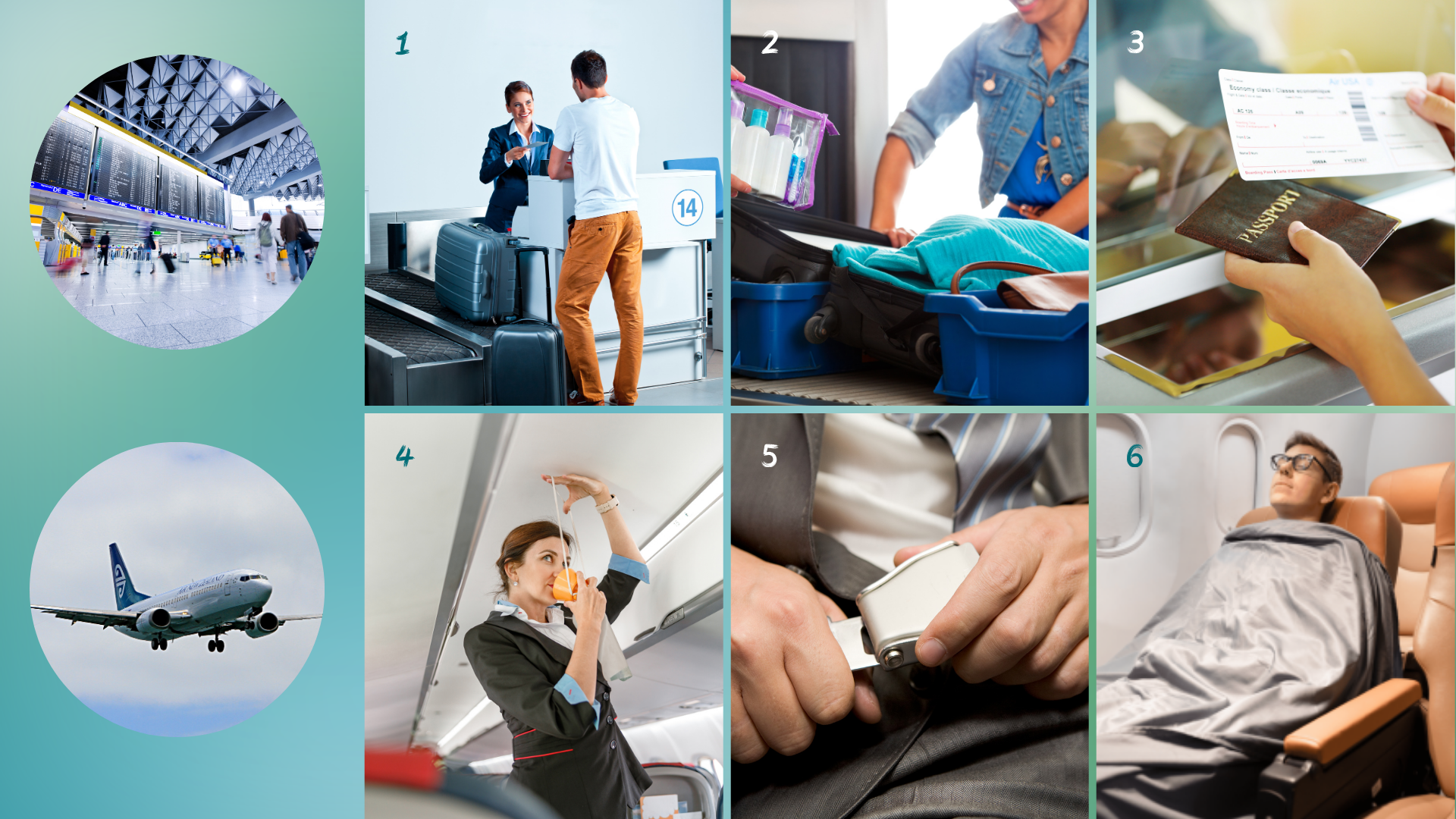This lesson focuses on essential Spanish vocabulary and dialogues for navigating the airport and airplane experience, targeting A2 learners. It includes practical situations like check-in, flight information, security checks, and safety instructions. Key grammar points include present perfect and reflexive verbs relevant to travel contexts, with dialogues and exercises reinforcing comprehension and conversational skills.
Listening & reading materials
Practice vocabulary in context with real materials.
A2.4.1 Lectura
¿Listo para embarcar? Sigue estos pasos en el aeropuerto
Ready to board? Follow these steps at the airport
Vocabulary (17) Share Copied!
Exercises Share Copied!
These exercises can be done together during conversation lessons or as homework.
Exercise 1: Translate and use in a sentence
Instruction: Pick a word, translated and use the word in a sentence or dialogue.
1
El pasaporte
The passport
2
Viajar en avión
To travel by plane
3
Ponerse cómodo
Make yourself comfortable
4
La tarjeta de embarque
The boarding pass
5
El carné de identidad
The identity card
Ejercicio 2: Conversation exercise
Instrucción:
- With the help of the pictures describe what you have to do in the airport and on the plane. (With the help of the pictures describe what you have to do in the airport and on the plane. )
- Do you like to fly? Why or why not? (Do you like to fly? Why or why not?)
Teaching guidelines +/- 10 minutes
Example phrases:
|
Tienes que obtener tu billete en el mostrador de facturación. You have to get your ticket at the check-in counter. |
|
Es necesario pasar por el control de seguridad. It is necessary to go through the security check. |
|
En el avión tienes que usar el cinturón de seguridad. In the plane you have to use your seatbelt. |
|
No me gusta volar porque el control de seguridad siempre tarda mucho. I don't like to fly because the security check takes always so long. |
|
Me gusta viajar en avión porque es muy rápido. I like going by plane because it is so fast. |
|
No me gustan los asientos del avión. No son cómodos. I don't like the airplane seats. They are not comfortable. |
|
El auxiliar de vuelo está mostrando las instrucciones de seguridad. The steward is showing the safety instructions. |
| ... |
Exercise 3: Dialogue Cards
Instruction: Select a situation and practice the conversation with your teacher or fellow students.
Exercise 4: Multiple Choice
Instruction: Choose the correct solution
1. He _____ por el control de seguridad sin problemas.
(I have _____ through security without problems.)2. Yo _____ mi tarjeta de embarque en el mostrador.
(I _____ my boarding pass at the counter.)3. El piloto _____ aterrizado el avión con mucha habilidad.
(The pilot _____ landed the plane with great skill.)Exercise 5: At the airport and on the plane
Instruction:
Verb Tables
Pasar - Pass
Pretérito perfecto
- yo he pasado
- tú has pasado
- él/ella/Ud. ha pasado
- nosotros/nosotras hemos pasado
- vosotros/vosotras habéis pasado
- ellos/ellas/Uds. han pasado
Mostrar - Show
Presente
- yo muestro
- tú muestras
- él/ella/Ud. muestra
- nosotros/nosotras mostramos
- vosotros/vosotras mostráis
- ellos/ellas/Uds. muestran
Abrocharse - Fasten
Presente
- yo me abrocho
- tú te abrochas
- él/ella/Ud. se abrocha
- nosotros/nosotras nos abrochamos
- vosotros/vosotras os abrocháis
- ellos/ellas/Uds. se abrochan
Ponerse - Put on
Presente
- yo me pongo
- tú te pones
- él/ella/Ud. se pone
- nosotros/nosotras nos ponemos
- vosotros/vosotras os ponéis
- ellos/ellas/Uds. se ponen
Aterrizar - Land
Pretérito perfecto
- yo he aterrizado
- tú has aterrizado
- él/ella/Ud. ha aterrizado
- nosotros/nosotras hemos aterrizado
- vosotros/vosotras habéis aterrizado
- ellos/ellas/Uds. han aterrizado
Levantarse - Get up
Pretérito perfecto
- yo me he levantado
- tú te has levantado
- él/ella/Ud. se ha levantado
- nosotros/nosotras nos hemos levantado
- vosotros/vosotras os habéis levantado
- ellos/ellas/Uds. se han levantado
Exercise 6: Adjectives: "Bonito", "Feo", "Bueno", "Malo", etc ...
Instruction: Fill in the correct word.
Grammar: Adjectives: "Bonito", "Feo", "Bueno", "Malo", etc ...
Show translation Show answersmalo, bonito, bueno, fuerte, débil
Grammar Share Copied!
It's not the most exciting thing, we admit, but it’s absolutely essential (and we promise it'll pay off)!
A2.4.2 Gramática
Adjectives: "Bonito", "Feo", "Bueno", "Malo", etc ...
Adjectives: "Bonito", "Feo", "Bueno", "Malo", etc ...
Verb conjugation tables for this lesson Share Copied!
Pasar to pass Share Copied!
Pretérito perfecto
| Spanish | English |
|---|---|
| (yo) he pasado | I have passed |
| (tú) has pasado | You have passed |
| (él/ella) ha pasado | he/she has passed |
| (nosotros/nosotras) hemos pasado | we have passed |
| (vosotros/vosotras) habéis pasado | You have passed |
| (ellos/ellas) han pasado | they have passed |
Mostrar show Share Copied!
Presente
| Spanish | English |
|---|---|
| (yo) muestro | I show |
| (tú) muestras | you show |
| (él/ella) muestra | he/she shows |
| (nosotros/nosotras) mostramos | we show |
| (vosotros/vosotras) mostráis | You show |
| (ellos/ellas) muestran | they show |
Don't see progress when learning on your own? Study this material with a certified teacher!
Do you want to practice Spanish today? That is possible! Just contact one of our teachers today.
At the Airport and on the Plane – Spanish A2 Lesson
This lesson guides you through essential Spanish vocabulary and dialogues you will need when traveling through an airport and flying by plane. It covers practical situations like checking in at the counter, asking for flight times and boarding gates, and passing through security control. The content is designed for A2-level learners who already have basic knowledge of Spanish and want to practice real-life conversations and relevant verb forms.
Key Vocabulary and Grammar
You will learn common adjectives such as bonito (beautiful), feo (ugly), bueno (good), and malo (bad), which can help describe places and experiences. The lesson also emphasizes verb conjugations in the present and past perfect (pretérito perfecto) tenses. Important verbs include pasar (to pass), mostrar (to show), abrocharse (to fasten oneself), ponerse (to put on), aterrizar (to land), and levantarse (to get up). These verbs appear in dialogues and exercises to improve your speaking and comprehension skills.
Dialogues and Practical Conversations
The lesson features realistic dialogues such as checking in your luggage at the counter (“Buenos días, ¿en qué puedo ayudarle?”), asking for flight schedules and gates (“¿A qué hora sale el vuelo?”), and going through security (“Por favor, saque su pasaporte”). Practicing these will prepare you to communicate effectively in Spanish airports and on planes.
Grammar Points and Differences
Spanish uses the present perfect tense (pretérito perfecto) to describe recent past actions related to the present, which is more common here than in some English situations where simple past is preferred. For example, He pasado por el control de seguridad literally means “I have passed through security,” emphasizing completion. Modal verbs and reflexive verbs appear frequently, such as me abrocho (I fasten myself) and me pongo (I put on). This differs from English where many reflexive verbs are simply expressed without a reflexive pronoun.
Useful Phrases and Tips
- ¿Dónde está la puerta de embarque? – Where is the boarding gate?
- Quisiera facturar mi maleta. – I would like to check my suitcase.
- ¿Puedo llevar líquidos en la mochila? – Can I carry liquids in my backpack?
- Abrocharse el cinturón de seguridad – Fasten your seatbelt.
Practice both listening and speaking with the dialogues and verb exercises to gain confidence and fluency in travel situations. This course material is tailored to provide both vocabulary and grammar in context, helping you navigate airports and flights confidently while learning everyday Spanish.




























